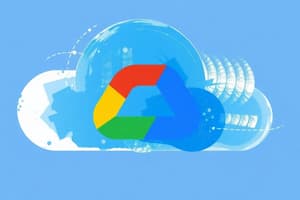Podcast
Questions and Answers
What is cloud computing defined as?
What is cloud computing defined as?
- The on-premise delivery of compute power, database, storage, applications, and other IT resources with capital expenditure.
- The on-demand delivery of software applications via the internet with subscription-based pricing.
- The on-demand delivery of compute power, database, storage, applications, and other IT resources via the internet with pay-as-you-go pricing. (correct)
- The on-demand delivery of hardware via the internet with fixed pricing.
How does cloud computing enable users to think of their infrastructure?
How does cloud computing enable users to think of their infrastructure?
- As hardware with physical security and capital expenditure.
- As a combination of hardware and software with long procurement cycles.
- As software without requiring space, staff, and physical security. (correct)
- As a hybrid of cloud and on-premise infrastructure with pay-as-you-go pricing.
What is a characteristic of traditional computing models?
What is a characteristic of traditional computing models?
- Long hardware procurement cycles and capital expenditure. (correct)
- Scalability and on-demand delivery of resources.
- Pay-as-you-go pricing and flexibility.
- Subscription-based pricing and physical security.
What is a benefit of cloud computing compared to traditional computing models?
What is a benefit of cloud computing compared to traditional computing models?
How does cloud computing differ from traditional computing models?
How does cloud computing differ from traditional computing models?
What is a key characteristic of cloud computing pricing?
What is a key characteristic of cloud computing pricing?
What is the equivalent of a traditional on-premises router in AWS?
What is the equivalent of a traditional on-premises router in AWS?
What is used in AWS for storing and retrieving data, similar to NAS in traditional IT?
What is used in AWS for storing and retrieving data, similar to NAS in traditional IT?
What is the equivalent of traditional firewalls in AWS?
What is the equivalent of traditional firewalls in AWS?
What is used in AWS for relational database management, similar to RDBMS in traditional IT?
What is used in AWS for relational database management, similar to RDBMS in traditional IT?
What is the equivalent of a traditional on-premises switch in AWS?
What is the equivalent of a traditional on-premises switch in AWS?
What is used in AWS for computing resources, similar to on-premises servers in traditional IT?
What is used in AWS for computing resources, similar to on-premises servers in traditional IT?
What is used in AWS for storing block-level data, similar to DAS in traditional IT?
What is used in AWS for storing block-level data, similar to DAS in traditional IT?
What is used in AWS for access control, similar to ACLs in traditional IT?
What is used in AWS for access control, similar to ACLs in traditional IT?
What is the benefit of trading capital expense for variable expense?
What is the benefit of trading capital expense for variable expense?
What is a characteristic of a web service?
What is a characteristic of a web service?
What is provided by AWS?
What is provided by AWS?
What is a benefit of using AWS?
What is a benefit of using AWS?
What is a disadvantage of running and maintaining data centers?
What is a disadvantage of running and maintaining data centers?
What is a characteristic of cloud computing?
What is a characteristic of cloud computing?
What is an advantage of going global in minutes?
What is an advantage of going global in minutes?
What is a benefit of massive economies of scale?
What is a benefit of massive economies of scale?
Flashcards are hidden until you start studying
Study Notes
Cloud Computing Overview
- Cloud computing is the on-demand delivery of compute power, database, storage, applications, and other IT resources via the internet with pay-as-you-go pricing.
- It enables thinking of infrastructure as software, rather than hardware.
Traditional Computing Model
- Traditional computing model requires:
- Space, staff, and physical security
- Planning and capital expenditure
- Long hardware procurement cycle
- Provisioning capacity based on guessing theoretical maximum peaks
Similarities between AWS and Traditional IT
- Security: Firewalls, ACLs, Administrators (Traditional IT) vs. Security groups, IAM (AWS)
- Networking: Router, Network pipeline, Switch (Traditional IT) vs. Elastic Load Balancing, Amazon VPC (AWS)
- Compute: On-premises servers (Traditional IT) vs. Amazon EC2, AMI, instances (AWS)
- Storage and Database: DAS, SAN, NAS, RDBMS (Traditional IT) vs. Amazon EBS, Amazon EFS, Amazon S3, Amazon RDS (AWS)
Cloud Computing Benefits
- Stop spending money on running and maintaining data centers
- Go global in minutes
- Trade capital expense for variable expense
- Benefit from massive economies of scale
- Stop guessing capacity
- Increase speed and agility
Introduction to Amazon Web Services (AWS)
- A web service is a piece of software that makes itself available over the internet and uses a standardized format (e.g. XML, JSON) for API interactions.
- AWS is a secure cloud platform that offers a broad set of global cloud-based products, providing on-demand access to compute, storage, network, database, and other IT resources and management tools.
Studying That Suits You
Use AI to generate personalized quizzes and flashcards to suit your learning preferences.




